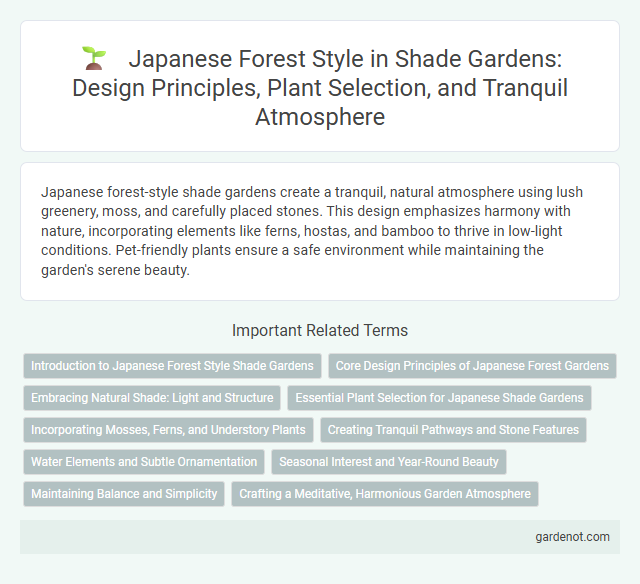Japanese forest-style shade gardens create a tranquil, natural atmosphere using lush greenery, moss, and carefully placed stones. This design emphasizes harmony with nature, incorporating elements like ferns, hostas, and bamboo to thrive in low-light conditions. Pet-friendly plants ensure a safe environment while maintaining the garden's serene beauty.
Introduction to Japanese Forest Style Shade Gardens
Japanese forest style shade gardens emphasize natural, tranquil settings inspired by ancient woodland landscapes. Characterized by layered plantings of ferns, mosses, and shade-tolerant trees like maple and cedar, these gardens create a serene atmosphere through organic textures and muted colors. Incorporating elements such as stone pathways, water features, and lanterns enhances the meditative quality while promoting biodiversity and seasonal interest.
Core Design Principles of Japanese Forest Gardens
Japanese forest gardens emphasize naturalistic design principles, such as asymmetry, simplicity, and the seamless integration of plants with their surrounding environment. The core design elements prioritize the use of native shade-tolerant species, layered plantings to mimic natural forest strata, and the creation of tranquil spaces through careful placement of stones, water features, and moss. These gardens foster harmony between humans and nature, reflecting a deep respect for seasonal changes and the spiritual essence of the forest landscape.
Embracing Natural Shade: Light and Structure
Japanese forest-style shade gardens masterfully harness dappled light filtered through layered canopies of maples and cryptomerias, creating a tranquil interplay of shadow and illumination. Structural elements such as moss-covered stones, winding paths, and bamboo fences emphasize natural textures and organic forms, enhancing the immersive woodland atmosphere. This design philosophy embraces the subtle variations of light and shade to cultivate a serene, meditative space grounded in harmony with nature.
Essential Plant Selection for Japanese Shade Gardens
Essential plant selection for Japanese shade gardens emphasizes shade-tolerant species such as hostas, ferns, and Japanese maples (Acer palmatum) to create serene, layered textures. Mosses and shade-loving groundcovers like ajuga (Ajuga reptans) enhance the tranquil forest floor effect while camellias and hydrangeas provide seasonal interest through blooms in dappled light. Prioritizing plants with varying leaf shapes, colors, and heights maintains the naturalistic and contemplative aesthetic central to Japanese forest garden design.
Incorporating Mosses, Ferns, and Understory Plants
Japanese forest-style shade gardens emphasize the harmonious integration of mosses, ferns, and understory plants to create a tranquil, naturalistic environment. Mosses form lush, green carpets that retain moisture and provide a soft texture, while ferns contribute intricate foliage and a graceful vertical element. Understory plants such as hostas and astilbes thrive in low-light conditions, enhancing biodiversity and complementing the layered structure typical of traditional Japanese forest gardens.
Creating Tranquil Pathways and Stone Features
Japanese forest-style shade gardens emphasize creating tranquil pathways lined with natural stone elements to enhance meditative experiences. These pathways often incorporate moss-covered stepping stones and carefully placed rocks that mimic natural landscapes, promoting a serene atmosphere. Integrating water features alongside stone lanterns further accentuates the calming ambiance characteristic of traditional Japanese garden design.
Water Elements and Subtle Ornamentation
Japanese forest-style shade gardens emphasize the harmonious integration of water elements, such as serene ponds, gentle streams, and trickling waterfalls, to evoke tranquility and natural rhythm. Subtle ornamentation like weathered stone lanterns, moss-covered sculptures, and simple wooden bridges enhances the garden's organic aesthetic without overwhelming the lush greenery. These features create a meditative environment that highlights balance, simplicity, and the timeless beauty of nature.
Seasonal Interest and Year-Round Beauty
Japanese forest-style shade gardens emphasize seasonal interest through diverse plant selections such as maples, ferns, and azaleas that offer vibrant autumn colors, delicate spring blossoms, and lush summer foliage. Year-round beauty is achieved by incorporating evergreen shrubs like rhododendrons and moss beds that maintain texture and greenery during winter months. Strategic layering of plants ensures continuous visual appeal, highlighting seasonal transitions while preserving the tranquil, naturalistic aesthetic characteristic of this garden style.
Maintaining Balance and Simplicity
Japanese forest-style shade gardens emphasize maintaining balance and simplicity by using natural materials and carefully selected plant species such as ferns, mosses, and shade-tolerant trees like maples and camellias. The design incorporates asymmetrical layouts, minimalistic stone arrangements, and soft, filtered light to create a tranquil, meditative atmosphere. Consistent pruning and seasonal attention ensure the garden's harmony and understated elegance are preserved year-round.
Crafting a Meditative, Harmonious Garden Atmosphere
Japanese forest style shade gardens emphasize natural elements like moss, ferns, and evergreens to create a tranquil, meditative atmosphere. Incorporating winding stone pathways and water features enhances harmony and reflects traditional Japanese aesthetics. Careful layering of plants and subtle lighting heightens the serene ambiance, fostering peaceful contemplation and connection with nature.
Japanese forest style Infographic

 gardenot.com
gardenot.com